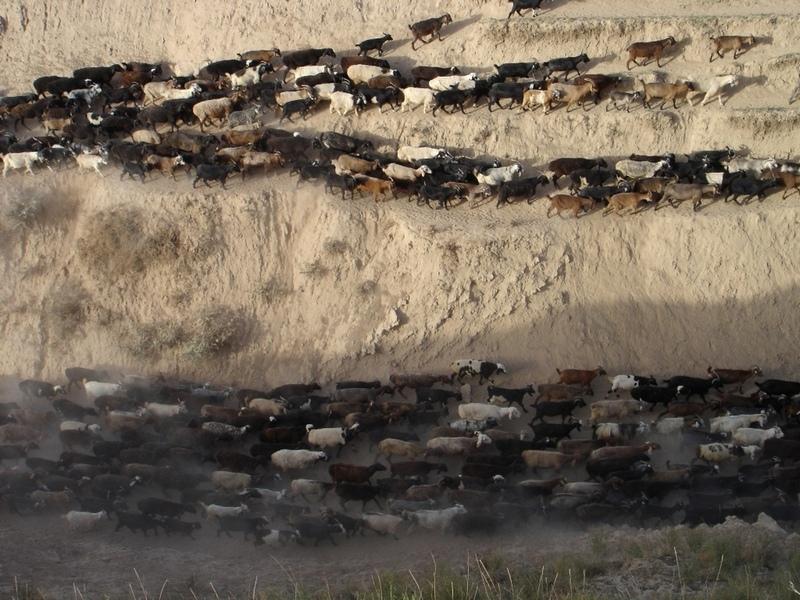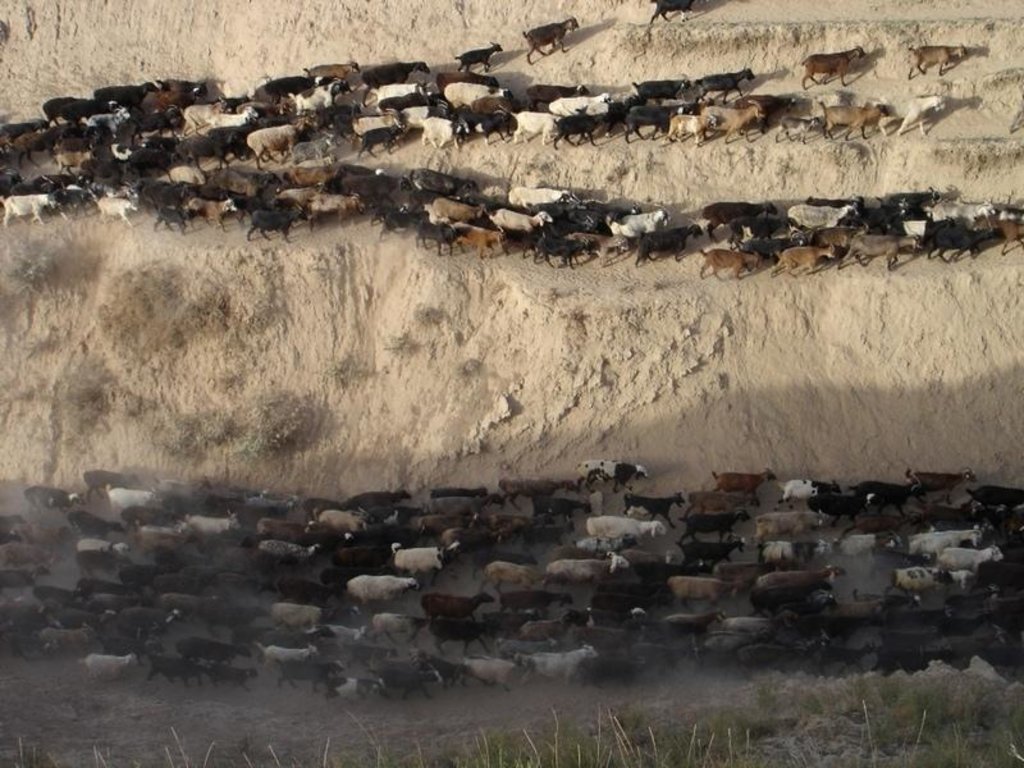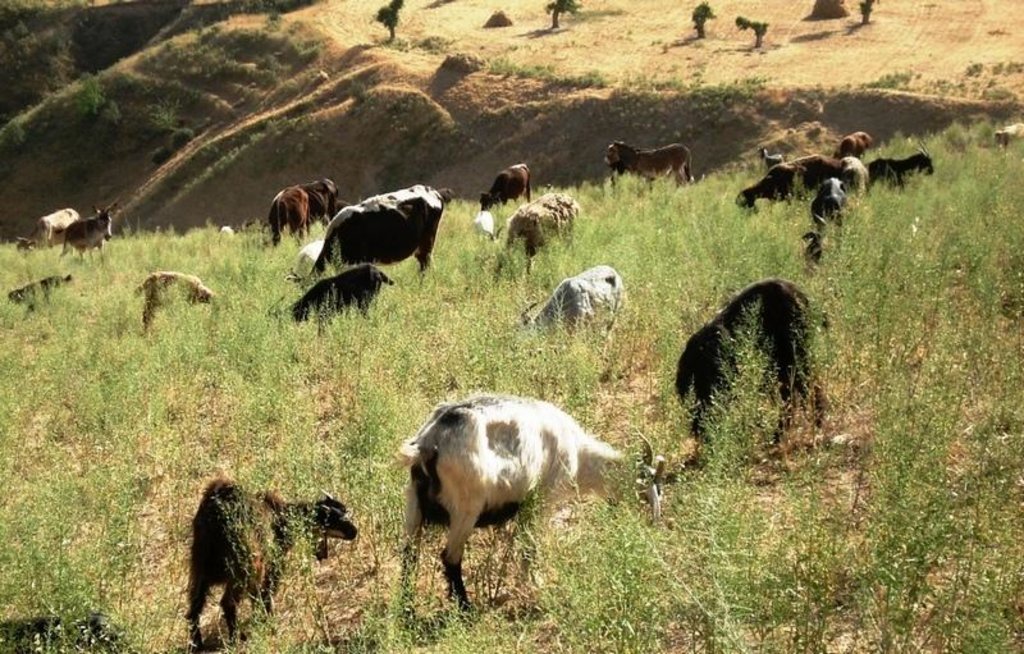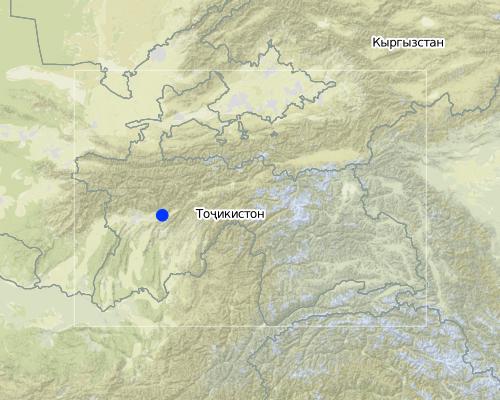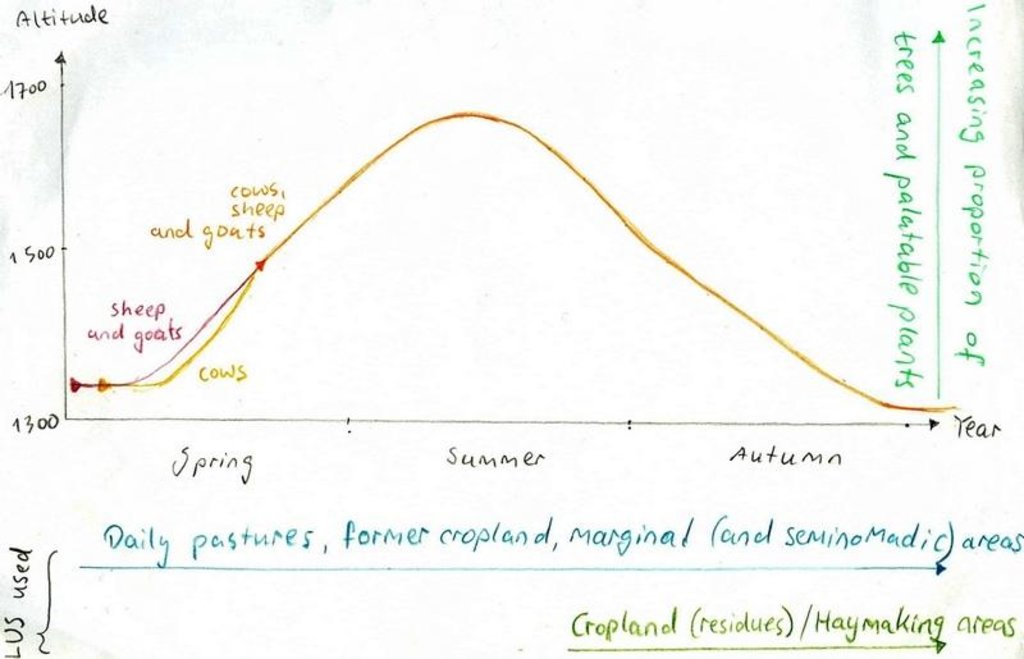Daily grazing of village-herds [ทาจิกิสถาน]
- ผู้สร้างสรรค์:
- การอัพเดท:
- ผู้รวบรวม: Christian Wirz
- ผู้เรียบเรียง: –
- ผู้ตรวจสอบ: David Streiff
Charogo bistumi (pasture for everyone)
technologies_1408 - ทาจิกิสถาน
ดูส่วนย่อย
ขยายทั้งหมด ย่อทั้งหมด1. ข้อมูลทั่วไป
1.2 รายละเอียดที่ติดต่อได้ของผู้รวบรวมและองค์กรที่เกี่ยวข้องในการประเมินและการจัดเตรียมทำเอกสารของเทคโนโลยี
ชื่อขององค์กรซึ่งอำนวยความสะดวกในการทำเอกสารหรือการประเมินเทคโนโลยี (ถ้าเกี่ยวข้อง)
CDE Centre for Development and Environment (CDE Centre for Development and Environment) - สวิตเซอร์แลนด์ชื่อขององค์กรซึ่งอำนวยความสะดวกในการทำเอกสารหรือการประเมินเทคโนโลยี (ถ้าเกี่ยวข้อง)
NCCR North-South (NCCR North-South) - คีร์กีซสถาน1.3 เงื่อนไขการใช้ข้อมูลที่ได้บันทึกผ่านทาง WOCAT
วันที่เก็บรวบรวมข้อมูล(ภาคสนาม) :
01/08/2008
ผู้รวบรวมและวิทยากรหลักยอมรับเงื่อนไขเกี่ยวกับการใช้ข้อมูลที่ถูกบันทึกผ่านทาง WOCAT:
ใช่
1.5 อ้างอิงไปที่แบบสอบถามเรื่องแนวทาง SLM
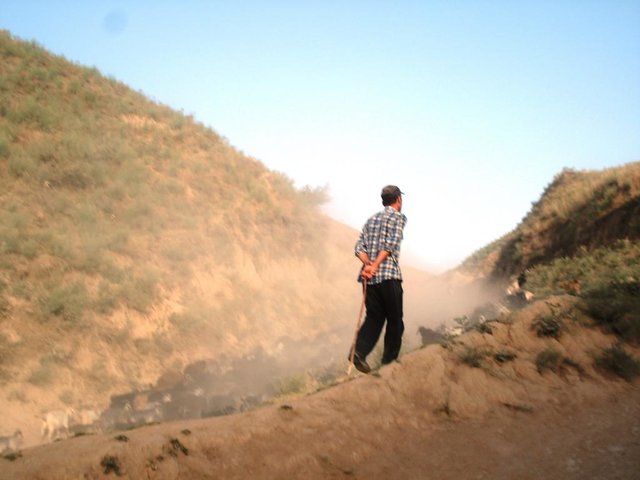
Common village herding [ทาจิกิสถาน]
Village herding system with daily alternation of the herders including each household in a monthly turnus.
- ผู้รวบรวม: Christian Wirz
2. การอธิบายลักษณะของเทคโนโลยี SLM
2.1 การอธิบายแบบสั้น ๆ ของเทคโนโลยี
คำจำกัดความของเทคโนโลยี:
Rotational grazing on village pastures with heavy pressure with daily to weekly change of grazing places.
2.2 การอธิบายแบบละเอียดของเทคโนโลยี
คำอธิบาย:
The herding season is from the beginnning of March to the End of Octobre or even beginning of Decembre. Total area is between 10-20 km2, depending on how strictly the borders are understood. Cows, sheep, goats and donkeys compose the herds. Grazing begins when soil moisture begins to decreaset, first with the little animals, that are supposed to better cope with slippery conditions. After two weeks the cows are led to the pastures and in some cases they will be grazed alone, because sheep and goats disturb them. The grazing zone is situated between 1400 and 1700 m. Rotation begins on the lower pastures, at the beginning of summer the higher pastures are used and towards autumn the animals graze near the villages again, sometimes on cropland, feeding on crop residues. The herders are advised to change place after 2-3 days, but often stay in one place for a longer time. The animals are gathered on the way out of the village a little after dawn, than brought to the pastures. At noon-time they will be lead to a shady place close to a stream, if possible. The same places are visited three or more times per season.
Purpose of the Technology: The animals should be nourished and the cows should give milk. A land user kept his cow at home towards the end of summer, because it stopped giving milk, from the sparse and dry vegetation on the pastures.
Establishment / maintenance activities and inputs: The costs for this form of herding are lost days at school for the children. It largely works without external inputs (such as fertilisers). Other inputs such as salt for the animals are covered by the landowner.
Natural / human environment: These pasture-areas are heaviliy suffering from overuse on one hand and from droughts on the other side. They are in a generally well-conserved state. Fractional vegetation cover is low, especially tree cover, and the proportion non-palatable species relatively high. Erosion by water, including gullies, and crusting, are common phenomena, especially in low cover areas.
2.3 รูปภาพของเทคโนโลยี
2.5 ประเทศภูมิภาค หรือสถานที่ตั้งที่เทคโนโลยีได้นำไปใช้และได้รับการครอบคลุมโดยการประเมินนี้
ประเทศ:
ทาจิกิสถาน
ภูมิภาค/รัฐ/จังหวัด:
Region of Republican Subordination
ข้อมูลจำเพาะเพิ่มเติมของสถานที่ตั้ง :
Faizabad
Map
×2.6 วันที่การดำเนินการ
ถ้าไม่รู้ปีที่แน่นอน ให้ระบุวันที่โดยประมาณ:
- มากกว่า 50 ปี (แบบดั้งเดิม)
2.7 คำแนะนำของเทคโนโลยี
ให้ระบุว่าเทคโนโลยีถูกแนะนำเข้ามาอย่างไร:
- เป็นส่วนหนึ่งของระบบแบบดั้งเดิมที่ทำก้นอยู่ (> 50 ปี)
ความคิดเห็น (ประเภทของโครงการ เป็นต้น) :
Already before the USSR the villages used to have their hamlets and grazed them around the villages, but also in the formerly not very populated plains. By the settlement of people in the plains and population growth from the 1970ies onward livestock numbers and pressure on natural resources started to increase there. And through Soviet collective agriculture people were forced to keep livestock close to the villages, as a consequence of their employment. In addition, grazing on the territory of forest administration, founded in the 1960ies, was forbidden for the villagers.
3. การจัดประเภทของเทคโนโลยี SLM
3.2 ประเภทของการใช้ที่ดินในปัจจุบันที่ได้นำเทคโนโลยีไปใช้

ทุ่งหญ้าเลี้ยงสัตว์
ทุ่งหญ้าเลี้ยงสัตว์ที่ใช้พื้นที่กว้าง:
- การทำฟาร์มปศุสัตว์ (Ranching)
ชนิดพันธุ์สัตว์และผลิตภัณฑ์หลัก:
sheep and goats / cows and donkeys.
แสดงความคิดเห็น:
Major land use problems (compiler’s opinion): Soils are heavily degraded in the sense of generally high levels of compaction and crusting and low organic matter contents. Vegetation is especially reduced in cover, not necessarily in biomass and, the fraction of good pasture species is low.
Major land use problems (land users’ perception): Many trees have been cut down during civil war and till today, leaving back a soil without protection. Animals grazing on these pastures are not fat, often sick and cows give little and sometimes (in summer) no milk. An often mentioned problem is the situation of drought in 2008 and animals staying in one place for longer periods, which leads to degradation of vegetation.
Ranching: sheep and goats / cows and donkeys.
Grazingland comments: In spring sheep and goats are herded before cows, then in a separate herd and toward the end of the season, together.
Type of grazing system comments: In spring sheep and goats are herded before cows, then in a separate herd and toward the end of the season, together.
3.3 ข้อมูลเพิ่มเติมเกี่ยวกับการใช้ที่ดิน
การใช้น้ำของที่ดินที่มีการใช้เทคโนโลยีอยู่:
- จากน้ำฝน
จำนวนของฤดูเพาะปลูกต่อปี:
- 1
ระบุ:
Longest growing period in days: 270Longest growing period from month to month: Oct - Jul
ความหนาแน่นของปศุสัตว์ (ถ้าเกี่ยวข้อง):
< 1 LU/km2
3.4 กลุ่ม SLM ที่ตรงกับเทคโนโลยีนี้
- การจัดการปศุสัตว์และทุ่งหญ้าเลี้ยงสัตว์
3.5 กระจายตัวของเทคโนโลยี
ระบุการกระจายตัวของเทคโนโลยี:
- กระจายไปอย่างสม่ำเสมอในพื้นที่
ถ้าหากว่าเทคโนโลยีได้มีการกระจายออกไปอย่างสม่ำเสมอในพื้นที่ ให้ระบุปริมาณพื้นที่ที่ได้รับการครอบคลุมถึง:
- 10-100 ตร.กม.
แสดงความคิดเห็น:
Total area covered by the SLM Technology is 15 m2.
For some villages figures are available, for instance for Karsang: This village has alltogether 850 ha of common grazing land, for officially 212 cows and 775 little animals. For the whole Jamoat the figures are of around 2500 ha of pasture-land (not all in the study-area) for 2695 cows and 5950 little animals.
3.6 มาตรการ SLM ที่ประกอบกันเป็นเทคโนโลยี

มาตรการอนุรักษ์ด้วยการจัดการ
- M1: การเปลี่ยนรูปแบบของการใช้ประโยชน์ที่ดิน
แสดงความคิดเห็น:
Main measures: management measures
3.7 รูปแบบหลักของการเสื่อมโทรมของที่ดินที่ได้รับการแก้ไขโดยเทคโนโลยี

การกัดกร่อนของดินโดยน้ำ
- Wt (Loss of topsoil): การสูญเสียดินชั้นบนหรือการกัดกร่อนที่ผิวดิน
- Wg (Gully erosion): การกัดกร่อนแบบร่องธารหรือการทำให้เกิดร่องน้ำเซาะ
- Wm (Mass movement): การเคลื่อนตัวของมวลดินหรือดินถล่ม

การเสื่อมโทรมของดินทางด้านชีวภาพ
- Bc (Reduction of vegetation cover): การลดลงของจำนวนพืชที่ปกคลุมดิน
แสดงความคิดเห็น:
Secondary types of degradation addressed: Wt: loss of topsoil / surface erosion, Wg: gully erosion / gullying, Wm: mass movements / landslides, Bc: reduction of vegetation cover
Main causes of degradation: overgrazing (Big livestock numbers on little surface.), poverty / wealth (People depend on livestock and on cheap pastures.)
Secondary causes of degradation: droughts (Many people mention that rainfalls were much lower in 2007-2008 than normally.), population pressure (Especially from the 1970ies onward population increased rapidly.), land tenure (As long as no-one is really responsible for the are, conservation measures are difficult to implement.), war and conflicts (Civil war was detrimental to the (little) economic, non-agricultural sector (textiles, car-parts) and to the institutions, so that many people had to return to agricultural activities.)
3.8 การป้องกัน การลดลง หรือการฟื้นฟูความเสื่อมโทรมของที่ดิน
ระบุเป้าหมายของเทคโนโลยีกับความเสื่อมโทรมของที่ดิน:
- ลดความเสื่อมโทรมของดิน
แสดงความคิดเห็น:
Main goals: mitigation / reduction of land degradation
4. ข้อมูลจำเพาะด้านเทคนิค กิจกรรมการนำไปปฏิบัติใช้ ปัจจัยนำเข้า และค่าใช้จ่าย
4.1 แบบแปลนทางเทคนิคของเทคโนโลยี
4.2 ข้อมูลจำเพาะด้านเทคนิคและการอธิบายแบบแปลนทางเทคนิค
Rotation of the village herds.
Location: Karsang and other villages. Faizabad
Date: 20.08.09
Technical knowledge required for land users: low (The practiced rotation follows the humour of the herders (often children) and is not complicated.)
Secondary technical functions: improvement of surface structure (crusting, sealing), increase of biomass (quantity)
Change of land use practices / intensity level: The begin of grazing and the rotation is fixed by a village committee. Animals should not stay at one place for longer than 3 days.
4.3 ข้อมูลทั่วไปเกี่ยวกับการคำนวณปัจจัยนำเข้าและค่าใช้จ่าย
อื่นๆ หรือสกุลเงินประจำชาติ (ระบุ):
Somoni
ระบุอัตราแลกเปลี่ยนจากดอลลาร์สหรัฐเป็นสกุลเงินท้องถิ่น (ถ้าเกี่ยวข้อง) คือ 1 เหรียญสหรัฐ =:
3.42
4.4 กิจกรรมเพื่อการจัดตั้ง
| กิจกรรม | ประเภทของมาตรการ | ช่วงเวลาดำเนินการ | |
|---|---|---|---|
| 1. | Villagers buy animals, usually 6-10 goats and / or sheep, 1-2 cows and / or donkeys. | ด้วยการจัดการ | Constantly size is regulated. |
4.5 ค่าใช้จ่ายของปัจจัยนำเข้าที่จำเป็นสำหรับการจัดตั้ง
| ปัจจัยนำเข้า | หน่วย | ปริมาณ | ค่าใช้จ่ายต่อหน่วย | ค่าใช้จ่ายทั้งหมดต่อปัจจัยนำเข้า | %ของค่าใช้จ่ายที่ก่อให้เกิดขึ้นโดยผู้ใช้ที่ดิน | |
|---|---|---|---|---|---|---|
| อื่น ๆ | buy the animals | per year | 1.0 | 1170.0 | 1170.0 | 100.0 |
| ค่าใช้จ่ายทั้งหมดของการจัดตั้งเทคโนโลยี | 1170.0 | |||||
4.6 การบำรุงรักษาสภาพหรือกิจกรรมที่เกิดขึ้นเป็นประจำ
| กิจกรรม | ประเภทของมาตรการ | ช่วงระยะเวลา/ความถี่ | |
|---|---|---|---|
| 1. | Per capita fee taxes | ด้วยการจัดการ | Once per year. |
| 2. | Buying concentrated feed, depending on the financial resources of the land user. | ด้วยการจัดการ | Bought once per year, for winter period. |
| 3. | Haymaking and / or buying, depending on labour, financial resources and livestock numbers. | ด้วยการจัดการ | June-July, respectively later, if bought. |
| 4. | Medecine and salt for animals | ด้วยการจัดการ | Irregularly, resp. daily to weekly. |
4.7 ค่าใช้จ่ายของปัจจัยนำเข้าและกิจกรรมที่เกิดขึ้นเป็นประจำที่ต้องการการบำรุงรักษา (ต่อปี)
| ปัจจัยนำเข้า | หน่วย | ปริมาณ | ค่าใช้จ่ายต่อหน่วย | ค่าใช้จ่ายทั้งหมดต่อปัจจัยนำเข้า | %ของค่าใช้จ่ายที่ก่อให้เกิดขึ้นโดยผู้ใช้ที่ดิน | |
|---|---|---|---|---|---|---|
| อื่น ๆ | Per capita fee taxes | per year | 12.0 | 1.0 | 12.0 | |
| อื่น ๆ | Buying concentrated feed | kg | 425.0 | 0.53 | 225.25 | |
| อื่น ๆ | Medecine and salt for the animals | for all animals | 1.0 | 45.0 | 45.0 | |
| ค่าใช้จ่ายทั้งหมดของการบำรุงรักษาสภาพเทคโนโลยี | 282.25 | |||||
แสดงความคิดเห็น:
The calculated costs apply to each land user's cost for this herding system.
4.8 ปัจจัยสำคัญที่สุดที่มีผลกระทบต่อค่าใช้จ่าย
ปัจจัยสำคัญที่สุดที่มีผลกระทบต่อค่าใช้จ่ายต่างๆ:
The most important cost factor is buying livestock. Recurrent costs are low, but rent fees for pastures are percieved as being high.
5. สิ่งแวดล้อมทางธรรมชาติและของมนุษย์
5.1 ภูมิอากาศ
ฝนประจำปี
- < 250 ม.ม.
- 251-500 ม.ม.
- 501-750 ม.ม.
- 751-1,000 ม.ม.
- 1,001-1,500 ม.ม.
- 1,501-2,000 ม.ม.
- 2,001-3,000 ม.ม.
- 3,001-4,000 ม.ม.
- > 4,000 ม.ม.
เขตภูมิอากาศเกษตร
- กึ่งแห้งแล้ง
Thermal climate class: subtropics
5.2 สภาพภูมิประเทศ
ค่าเฉลี่ยความลาดชัน:
- ราบเรียบ (0-2%)
- ลาดที่ไม่ชัน (3-5%)
- ปานกลาง (6-10%)
- เป็นลูกคลื่น (11-15%)
- เป็นเนิน (16-30%)
- ชัน (31-60%)
- ชันมาก (>60%)
ธรณีสัณฐาน:
- ที่ราบสูง/ที่ราบ
- สันเขา
- ไหล่เขา
- ไหล่เนินเขา
- ตีนเนิน
- หุบเขา
ระดับความสูง:
- 0-100 เมตร
- 101-500 เมตร
- 501-1,000 เมตร
- 1,001-1,500 เมตร
- 1,501-2,000 เมตร
- 2,001-2,500 เมตร
- 2,501-3,000 เมตร
- 3,001-4,000 เมตร
- > 4,000 เมตร
ความคิดเห็นและข้อมูลจำเพาะเพิ่มเติมเรื่องสภาพภูมิประเทศ:
Altidudinal zone: Most pastures are close to the villages, on around 1300-1500 m, but some pastures reach altitudes of 1600-1700 m.
Landforms: The pasture-areas usually follow N-S-ridges and most pastures are in slope-areas.
Slopes on average: Also hilly
5.3 ดิน
ค่าเฉลี่ยความลึกของดิน:
- ตื้นมาก (0-20 ซ.ม.)
- ตื้น (21-50 ซ.ม.)
- ลึกปานกลาง (51-80 ซ.ม.)
- ลึก (81-120 ซ.ม.)
- ลึกมาก (>120 ซ.ม.)
เนื้อดิน (ดินชั้นบน):
- ปานกลาง (ดินร่วน ทรายแป้ง)
อินทรียวัตถุในดิน:
- ต่ำ (<1%)
(ถ้ามี) ให้แนบคำอธิบายเรื่องดินแบบเต็มหรือระบุข้อมูลที่มีอยู่ เช่น ชนิดของดิน ค่า pH ของดินหรือความเป็นกรดของดิน ความสามารถในการแลกเปลี่ยนประจุบวก ไนโตรเจน ความเค็ม เป็นต้น:
Soil texture (topsoil): Loess soils
Soil fertility low: In most places high proportions of non-graminoids and leguminous species.
Topsoil organic matter: High proportion of hot-spots and degrading areas according to Wolfgramm's (2007) hot-brightspot-map.
Soil drainage / infiltration poor: Most soils are crusted and compacted.
5.4 ความเป็นประโยชน์และคุณภาพของน้ำ
ระดับน้ำใต้ดิน:
> 50 เมตร
น้ำไหลบ่าที่ผิวดิน:
ไม่ดีหรือไม่มีเลย
คุณภาพน้ำ (ที่ยังไม่ได้บำบัด):
เป็นน้ำเพื่อการดื่มที่ไม่ดี (จำเป็นต้องได้รับการบำบัด)
ความคิดเห็นและข้อมูลจำเพาะเพิ่มเติมเรื่องคุณภาพและปริมาณน้ำ:
Ground water table: Often no groundwater, because too hilly
Availability of surface water: Most areas far from open water bodies
Water quality (untreated): No pesticides, but water is contaminated by animal dung.
5.5 ความหลากหลายทางชีวภาพ
ความหลากหลายทางชนิดพันธุ์:
- ต่ำ
ความคิดเห็นและข้อมูลจำเพาะเพิ่มเติมของความหลากหลายทางชีวภาพ:
In comparison with other areas.
5.6 ลักษณะของผู้ใช้ที่ดินที่นำเทคโนโลยีไปปฏิบัติใช้
แนวทางการตลาดของระบบการผลิต:
- เพื่อการยังชีพ (หาเลี้ยงตนเอง)
- ทำการค้า/การตลาด
รายได้ที่มาจากนอกฟาร์ม:
- > 50% ของรายได้ทั้งหมด
ระดับของความมั่งคั่งโดยเปรียบเทียบ:
- พอมีพอกิน
เป็นรายบุคคล/ครัวเรือน:
- เป็นรายบุคคล/ครัวเรือน
เพศ:
- หญิง
- ชาย
ระบุลักษณะอื่นๆที่เกี่ยวข้องของผู้ใช้ที่ดิน:
Land users applying the Technology are mainly common / average land users
Difference in the involvement of women and men: Many children are working as herders, because of labour shortage (young men in Russia).
Population density: < 10 persons/km2
Annual population growth: 1% - 2%
30% of the land users are rich (People who have a house made of concrete or with a ribbed roof instead of one made of cement asbesto).
70% of the land users are average wealthy (Compared to the rest of society: People have enough food, children go to school, they have a mud-hou).
Off-farm income specification: Nearly all people have family members (mostly sons) in Russia, who send remittances.
Market orientation of production system subsistence (self-supply): Animals are mainly used for own consumption (meat and milk).
Market orientation of production system commercial / market: Animals are sold, if the family needs money (for medecine or education).
So, it is still better from their perspective to have animals ("as a bank", according to many villagers), than not having this security. And it is comparatively cheap, even if a land user admits that he has to feed his cow with leaves of his muleberry trees, because pastures are so unproductive, that his cow does not give milk anymore (in August).
5.7 พื้นที่เฉลี่ยของที่ดินที่เป็นเจ้าของหรือเช่าโดยผู้ใช้ที่ดินที่นำเทคโนโลยีไปปฏิบัติใช้
- < 0.5 เฮกตาร์
- 0.5-1 เฮกตาร์
- 1-2 เฮกตาร์
- 2-5 เฮกตาร์
- 5-15 เฮกตาร์
- 15-50 เฮกตาร์
- 50-100 เฮกตาร์
- 100-500 เฮกตาร์
- 500-1,000 เฮกตาร์
- 1,000-10,000 เฮกตาร์
- >10,000 เฮกตาร์
พิจารณาว่าเป็นขนาดเล็ก กลาง หรือขนาดใหญ่ (ซึ่งอ้างอิงถึงบริบทระดับท้องถิ่น):
- ขนาดเล็ก
แสดงความคิดเห็น:
Average area of land owned or leased by land users applying the Technology 2-5 ha: This corresponds to the average for the whole study-area, including haymaking areas.
Average area of land owned or leased by land users applying the Technology 5-15 ha: Households having a farmer's association mostly have more than the average.
Average area of land owned or leased by land users applying the Technology 15-50 ha: Some rich families even have more land that they rent to others.
5.8 กรรมสิทธิ์ในที่ดิน สิทธิในการใช้ที่ดินและสิทธิในการใช้น้ำ
กรรมสิทธิ์ในที่ดิน:
- รัฐ
สิทธิในการใช้ที่ดิน:
- เข้าถึงได้แบบเปิด (ไม่ได้จัดระเบียบ)
- เกี่ยวกับชุมชน (ถูกจัดระเบียบ)
แสดงความคิดเห็น:
Pasture-use is theoretically regulated as described above, but additionally to the village herd there are other herders with private animals using the same pastures.
5.9 การเข้าถึงบริการและโครงสร้างพื้นฐาน
สุขภาพ:
- จน
- ปานกลาง
- ดี
การศึกษา:
- จน
- ปานกลาง
- ดี
ความช่วยเหลือทางด้านเทคนิค:
- จน
- ปานกลาง
- ดี
การจ้างงาน (เช่น ภายนอกฟาร์ม):
- จน
- ปานกลาง
- ดี
ตลาด:
- จน
- ปานกลาง
- ดี
พลังงาน:
- จน
- ปานกลาง
- ดี
ถนนและการขนส่ง:
- จน
- ปานกลาง
- ดี
น้ำดื่มและการสุขาภิบาล:
- จน
- ปานกลาง
- ดี
บริการด้านการเงิน:
- จน
- ปานกลาง
- ดี
6. ผลกระทบและสรุปคำบอกกล่าว
6.1 ผลกระทบในพื้นที่ดำเนินการ (On-site) จากการใช้เทคโนโลยี
ผลกระทบทางด้านเศรษฐกิจและสังคม
การผลิต
คุณภาพพืชที่ใช้เลี้ยงปศุสัตว์
แสดงความคิดเห็น/ระบุ:
Compared with all other areas the proportion of forbs is very high.
การผลิตสัตว์
แสดงความคิดเห็น/ระบุ:
Compared with an efficient grazing rotation, returns (in terms of milk and meat) are very low.
การผลิตไม้
แสดงความคิดเห็น/ระบุ:
Very little trees are left because of goats eating them.
ความหลากหลายของผลิตภัณฑ์
แสดงความคิดเห็น/ระบุ:
During war most people depended on cropland (wheat).
รายได้และค่าใช้จ่าย
ภาระงาน
แสดงความคิดเห็น/ระบุ:
This system does not depend on professional herders, is thus economic, also in financial terms.
ผลกระทบด้านสังคมวัฒนธรรมอื่น ๆ
ความมั่นคงด้านอาหาร / พึ่งตนเองได้
แสดงความคิดเห็น/ระบุ:
It is better for land users to have communal pastures but worse than having a well-implemented rotational grazing system, but the family does not have to buy meat.
สถาบันของชุมชน
Livelihoods and human well-being
ผลกระทบด้านนิเวศวิทยา
วัฐจักรน้ำหรือน้ำบ่า
น้ำไหลบ่าที่ผิวดิน
แสดงความคิดเห็น/ระบุ:
Especially trampling paths of livestock are very vulnerable to water erosion
ดิน
การเกิดแผ่นแข็งที่ผิวดิน /การเกิดชั้นดาน
แสดงความคิดเห็น/ระบุ:
The degree of compaction is higher than elsewhere.
การอัดแน่นของดิน
แสดงความคิดเห็น/ระบุ:
The degree of compaction is higher than elsewhere.
อินทรียวัตถุในดิน/ต่ำกว่าดินชั้น C
แสดงความคิดเห็น/ระบุ:
Organic matter is very low compared with all other areas. Biomass might be stonger reduced with animals grazing earlier in spring.
ความหลากหลายทางชีวภาพของพืชและสัตว์
มวลชีวภาพ/เหนือดินชั้น C
6.3 การเผชิญและความตอบสนองของเทคโนโลยีต่อการเปลี่ยนแปลงสภาพภูมิอากาศที่ค่อยเป็นค่อยไป และสภาพรุนแรงของภูมิอากาศ / ภัยพิบัติ (ที่รับรู้ได้โดยผู้ใช้ที่ดิน)
สภาพรุนแรงของภูมิอากาศ (ภัยพิบัติ)
ภัยพิบัติทางอุตุนิยมวิทยา
| เทคโนโลยีมีวิธีการรับมืออย่างไร | |
|---|---|
| พายุฝนประจำท้องถิ่น | ไม่ค่อยดี |
ภัยพิบัติจากสภาพภูมิอากาศ
| เทคโนโลยีมีวิธีการรับมืออย่างไร | |
|---|---|
| ภัยจากฝนแล้ง | ไม่ค่อยดี |
แสดงความคิดเห็น:
Pasture areas, that remain the same since the USSR, could be changed every few years to permit their recovery and regrowth of trees, chopped during and after civil war. The very basic rotational schemes existing in all villages are little effective. It is not possible to recognise conservation effects due to the generally very critical state of resources.
6.4 การวิเคราะห์ค่าใช้จ่ายและผลประโยชน์ที่ได้รับ
ผลประโยชน์ที่ได้รับเปรียบเทียบกับค่าใช้จ่ายในการจัดตั้งเป็นอย่างไร (จากมุมมองของผู้ใช้ที่ดิน)
ผลตอบแทนระยะสั้น:
ด้านบวก
ผลตอบแทนระยะยาว:
ด้านบวกเล็กน้อย
ผลประโยชน์ที่ได้รับเปรียบเทียบกับค่าใช้จ่ายในการบำรุงรักษาหรือต้นทุนที่เกิดขึ้นซ้ำอีก เป็นอย่างไร (จากมุมมองของผู้ใช้ที่ดิน)
ผลตอบแทนระยะสั้น:
ด้านบวก
ผลตอบแทนระยะยาว:
ด้านบวกเล็กน้อย
แสดงความคิดเห็น:
The land users see the problem of reduced productivity when pastures are overexploited. They complain about having to sell animals, but mainly attribute this to droughts.
6.5 การปรับตัวของเทคโนโลยี
ถ้ามีข้อมูลให้บอกปริมาณด้วย (จำนวนของครัวเรือนหรือครอบคลุมพื้นที่):
NA
จากทั้งหมดที่ได้รับเทคโนโลยีเข้ามามีจำนวนเท่าใดที่ทำแบบทันที โดยไม่ได้รับการจูงใจด้านวัสดุหรือการเงินใด ๆ:
- 90-100%
แสดงความคิดเห็น:
Comments on acceptance with external material support: No subsidies have been paid for buying livestock. But, as people highly depend on remittances, it can be assumed that these have also been invested into livestock.
100% of land user families have adopted the Technology without any external material support
There is a moderate trend towards spontaneous adoption of the Technology
Comments on adoption trend: Young families who do not yet have livestock are thinking of buying animals in the future. On the other hand herding in the upper areas still has potential and wealthy people might want to send their animals there with professional herders in the future.
6.7 จุดแข็ง / ข้อได้เปรียบ / โอกาสของเทคโนโลยี
| จุดแข็ง / ข้อได้เปรียบ / โอกาสในทัศนคติของผู้ใช้ที่ดิน |
|---|
|
Animal husbandry is an economic basis which permits development. How can they be sustained / enhanced? People should be allowed to keep as much animals as they want to. And the pasture-area should not become smaller. |
| จุดแข็ง / ข้อได้เปรียบ / โอกาสในทัศนคติของผู้รวบรวมหรือวิทยากรหลัก |
|---|
|
It is the most cheap form of self-sufficient meat-production. How can they be sustained / enhanced? Pasture-quality needs to be preserved, otherwise the carrying-capacity of pastures will be reduced. |
|
Livestock with its semimonetary value is much more stable in value than money on the bank (increasing livestock prices). How can they be sustained / enhanced? Only if alternatives for animal husbandry emerge will the prices for livestock not fall. |
6.8 จุดอ่อน / ข้อเสียเปรียบ / ความเสี่ยงของเทคโนโลยีและวิธีการแก้ไข
| จุดอ่อน / ข้อเสียเปรียบ / ความเสี่ยงในทัศนคติของผู้ใช้ที่ดิน | มีวิธีการแก้ไขได้อย่างไร |
|---|---|
| Animals and pastures are less productive (reduced biomass) and pastures show more signs of erosion than those on forest department. There, pasture-areas are bigger and, by consequence, there is more space for herding. | If there were not always more people affording to rent land for orchards or haymaking the pressure on the remaining pastures would not increase. |
| The pastures very much depend on enough water: If there is little rain (like in 2008) animals return hungry from the pastures. | There is hope that the planned water pipe from Rogun (planned giant dam) will bring water for irrigation (of cropland, where animals graze in late summer and where forbs are collected as winter fodder). |
| Rent fees have to be paid, which are percieved as high by some land users. They fear additional per-capita animal taxes. | No more taxes should be introduced and herding should not be stronger regulated, because many people depend on animal husbandry. |
| This herding system is vulnerable to droughts and temperature increase, which are percieved as main degradation causes. Besides this, excessive livestock numbers are seen as a cause of cover reduction and compaction. Especially where animals graze the soil is naked and dry after 2-3 days. | It might be helpful to let the pastures recover for 3-5 years for trees (which bring moisture) to grow. But this might require administration through external institutions and people fear that they will not get back the pastures. |
| จุดอ่อน / ข้อเสียเปรียบ / ความเสี่ยงในทัศนคติของผู้รวบรวมหรือวิทยากรหลัก | มีวิธีการแก้ไขได้อย่างไร |
|---|---|
| Degradation of soils and vegetation on these relatively small areas is high and the pastures cannot recuperate due to constant pressure. | The pastures need to have periods of recovery. |
| The soils are decreasing in fertility because animal dung is used as energy source. | A not too expensive alternative for hot water might be solar heaters or charcoal. And to counteract general fertility problems interchanging pasture- and haymaking areas would bring dung everywhere. But this would require fencing of the remaining trees in order not to further damage vegetation cover. |
ลิงก์และโมดูล
ขยายทั้งหมด ย่อทั้งหมดลิงก์

Common village herding [ทาจิกิสถาน]
Village herding system with daily alternation of the herders including each household in a monthly turnus.
- ผู้รวบรวม: Christian Wirz
โมดูล
ไม่มีโมดูล


